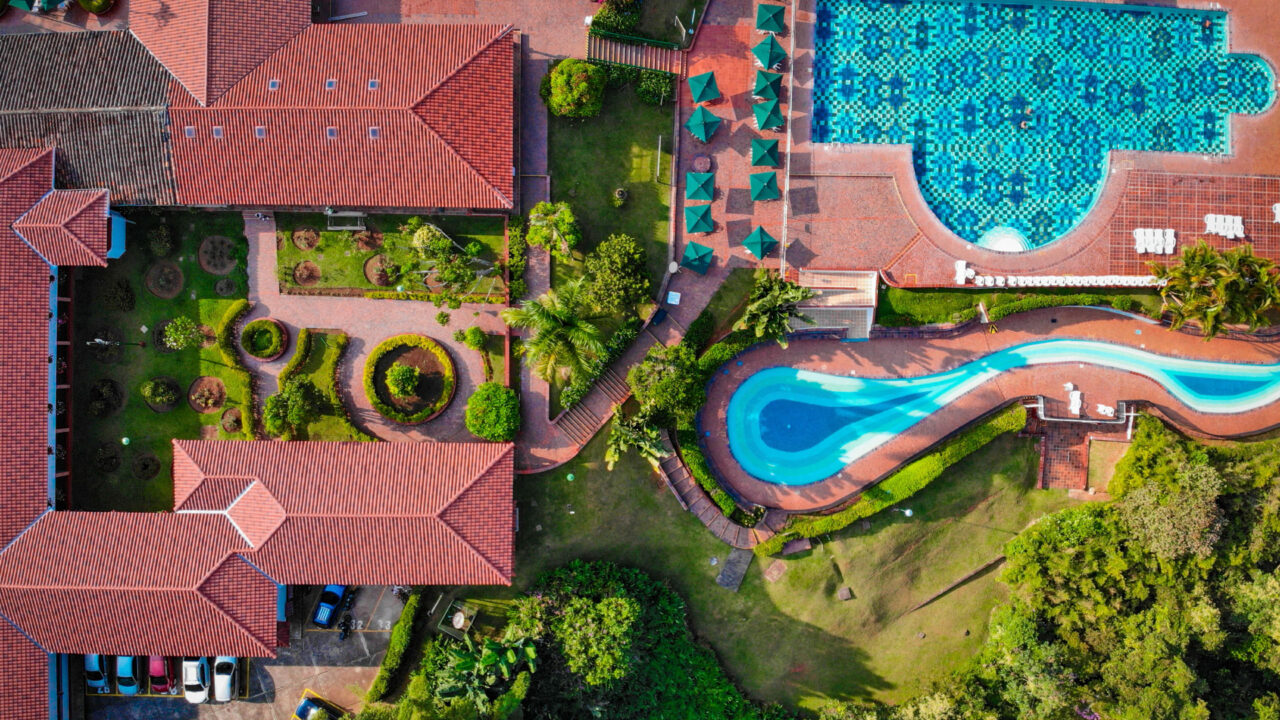Destinations and tourist attractions near Yanaconas
Los Farallones de Cali National Park
From Cali, on clear days, you can see the majestic blue peaks of the Farallones de Cali, it is located in the southwestern part of Valle del Cauca, in the jurisdiction of Cali, Jamundí, Dagua and Buenaventura.
They rise separating the basins of the Pacific and the Cauca River in the imposing Western Cordillera. The Farallones are the youngest rock formations in the Andes. It is the largest protected area in Valle del Cauca, where more than 540 species of birds are preserved and more than 30 rivers that supply the Colombian southwest are born. It is also a reservoir of diversity of unique and endangered species in Colombia and in the world. There, the Pance River not only becomes a visitor's guide to the Topacio area, the gateway to the protected area, it is also an early sample of the hydrographic wealth that the region contains.
Fauna
The park is inhabited by numerous species of mammals from small bats (80 species) to the Andean bear. There are also eight species of marsupials and five of primates such as the corn monkey (Cebus capucinus), red howler monkey (Alouatta seniculus) and marimonda (Ateles paniscus rufiventris); it also has anteaters (Myrmecophaga trydactila and Tamandula mexicana), sloths (Choloepus hoffmanni and Bradypuss infuscatus) and squirrels (Sciurus granatensis and Microsciurus pucheranii caucensis). But the birds are the queens of the park's fauna. The existence of more than 540 species with a high number of endemisms has been calculated. Among them we can highlight: Pacific umbrella-eater (Cephalopterus penduliger), multicolored tanager (Chlorochrysa nitidissima), yellow-green montero (Chlorospingus flavovirens), caucana guan (Penelope perspicax), rock cock (Rubicola peruviana) and traupid (Bangsia rothschildii). Lehman's poisonous frog (Oophaga lehmanni) also stands out.
Flora
The hydrographic wealth of the protected area is represented in a flow in the slopes of the Pacific Ocean and the Cauca River that, in addition to providing water to the main populated centers and aqueducts of the towns of Cali, Jamundí, Dagua and Buenaventura, feeds two dams. , the Alto and Bajo Anchicayá reservoirs, which generate electricity for the country. Some important rivers are the Cali, Pance, Claro and Jamundí rivers and in the Pacific region the Anchicayá rivers (the longest river in the park), Raposo, Cajambre, Yurumanguí and Naya whose waters are for domestic consumption by local communities. The great water supply of the park, with more than 30 rivers and 84 permanent streams, contributes to the social and cultural development of Valle del Cauca and supplies the 30% (around 600,000 people) of Cali.
Hydrography
The hydrographic wealth of the protected area is represented in a flow in the slopes of the Pacific Ocean and the Cauca River that, in addition to providing water to the main populated centers and aqueducts of the towns of Cali, Jamundí, Dagua and Buenaventura, feeds two dams. , the Alto and Bajo Anchicayá reservoirs, which generate electricity for the country. Some important rivers are the Cali, Pance, Claro and Jamundí rivers and in the Pacific region the Anchicayá rivers (the longest river in the park), Raposo, Cajambre, Yurumanguí and Naya whose waters are for domestic consumption by local communities. The great water supply of the park, with more than 30 rivers and 84 permanent streams, contributes to the social and cultural development of Valle del Cauca and supplies the 30% (around 600,000 people) of Cali.
communities
Afro-Colombians: The Afro-Colombian communities in the area are organized in the Community Councils of Black Communities of the Buenaventura basins (Mayorquín, Cajambre, Raposo Yurumanguí and Naya) and in the Community Councils of the Digua - San Juan - Anchicayá basin. After the abolition of slavery, the first group settled in this area along the basins developing ancestral activities such as fishing, agriculture and hunting. The second group arrived in the territory with the construction of the old road to the sea in the 1930s. Currently, these communities subsist by traditional activities of fishing, agriculture and hunting, as well as small-scale cattle ranching and extraction of construction materials mainly for domestic purposes.
Natives: The origin of the population that today makes up the Kwes'x Kiwe Nasa Indigenous Council of Alto de la Mona, is related to the origin myth of the Nasa people where their ancestors are one (woman who weaves life) and Tay (man who builds life). Although the Nasa population that today settles in a sector of the Anchicayá basin has mostly come from other municipalities and departments, they assure that since 2010 they have been in the process of returning to their lands, since their ancestors inhabited the where the Yatacue camp of the Alto Anchicayá Hydroelectric Power Plant of the Pacific Energy Company SA - EPSA -EPS is located today, and who were violently displaced between the 1950s and 1960s when the construction of the dams began.
Rural population: There are peasants, settlers and floating population. The floating population refers to the group that visits the protected area and has no identity ties in relation to the land.
Communities and conservation: Seven territories have been defined for the Pacific region and two territories for the Andean region. There are thirteen community councils for processes of black communities, two reservations and two councils of indigenous ethnic groups, with which they have been coordinating activities aimed at conservation.
Some representative places

The Virgin of Yanaconas
Our Lady of the Andes, better known as the Virgin of Yanaconas, is located in rural Cali. It was built on the initiative of the Marist brothers on the occasion of the commemoration of the Marian year. The natural landscape that can be seen from the monument is beautiful and the panoramic view of the city is incredible.

Christ the King
It is an excellent viewpoint. Famous place for the battle waged between General Eliseo Payán and Julio Arboleda on April 11, 1862, in which they communicated through mirrors (crystals), hence the name Cerro de los Cristales.

Felidia
The corregimiento has enormous natural wealth, thanks to the fact that the 75% of its area is located within the PNN Farallones and other forest reserve areas of Cali. It is located on the Western Cordillera, in the Cali River basin, sub-basin of the Felidia River. It is made up of eight villages: El Diamante, La Soledad, El Cidral, La Ascensión, La Esperanza, Santa Helena, Felidia Cabecera and Las Nieves.

Pichinde
The township of Pichindé is located in the western mountain range of the municipality of Santiago de Cali. Located at a height of 1,500 – 1,700 meters above sea level. Limited to the north with La Leonera, to the south, to the west and to the east with the corregimiento de los Andes. Pichindé is made up of 3 villages: Pichindé (cabera), Peñas Blancas and Lomas de la Cajita.

The Salty
One of the oldest corregimientos, it stands out as a cultural reference, for pilgrimage to the church of the Sacred Heart of Jesus and Mary. Several artists dedicated to oil painting and sculpture reside here. The San Antonio Forest is one of the most important natural attractions in the area, whose state of conservation guarantees bird watching.

The Andes
It is located in the hillside area of Cali, on the Western Cordillera and made up of 14 villages. The corregimiento has a great landscape, water, fauna and flora diversity, it is also recognized for having two of the three most important peripheral religious monuments of the city: Cristo Rey and the Virgin of Yanaconas.

The Elvira
It is located northwest of Cali, on the Western Cordillera, in the upper part of the Aguacatal river basin. It is located in a Forest Reserve area with the exception of the Elvira – header. Limited to the west by Dagua, to the northwest by the highest point of the Aguacatal river basin and La Cumbre; to the northeast with Yumbo and to the southwest with the corregimientos La Castilla and El Saladito. It is made up of four villages: Los Laureles, La Elvira Cabecera, km 18 and Alto Aguacatal.

Andoke
Andoke Foundation, a butterfly farm, is a peri-urban proposal for environmental education and experimentation. Just 10 minutes from the Yanaconas Hotel and Recreation Center, in its first mountains to the west, Andoke represents an unusual, attractive and educational experience for visitors.
A paradise that you must visit!... A world of butterflies in the open sky, accompanied by the three-dimensional map of Colombia; there you will fall more in love with the geography of our country. Vertical and aquatic gardens, nursery and climbing wall, handicrafts made with butterfly wings.

kantu
At 1,800 meters above sea level is Kantu; an ecological reserve with beautiful landscapes, trails, lodging and a viewpoint where you can see the Central Cordillera and some snow-capped mountains. Kantú is inside a tropical humid forest, few of which remain in the world and the host communities of the sector promote and apply themselves to the preservation of the environment. Further on, in Vereda La Soledad, in Felidia, is Villa Ceci; a farm for rest; Dona Ceci and her family make tourists feel like family. A pleasant atmosphere, Colombian music, accommodation, attention to events and something funny: Sonia the sow; a swine so big it looks like a hippopotamus. In this place, the La Soledad ravine, the Felidia and Pichindé rivers join their waters and join the Cali river; which then supplies the San Antonio aqueduct. On the way to La Elvira, within kilometer 18 on the road to the sea, is Alejandría, immersed in a cloud forest, a warm cabin, with a fireplace, a wide viewpoint, the corner of fairies, bird watching. More than 10 different species arrive per day, where the hummingbird is the king; dozens of them live with visitors and the best time to appreciate them is between September and March. You can also appreciate, at a certain time, the Quetzal; the only species around here.
A paradise that you must visit!... A world of butterflies in the open sky, accompanied by the three-dimensional map of Colombia; there you will fall more in love with the geography of our country. Vertical and aquatic gardens, nursery and climbing wall, handicrafts made with butterfly wings.


